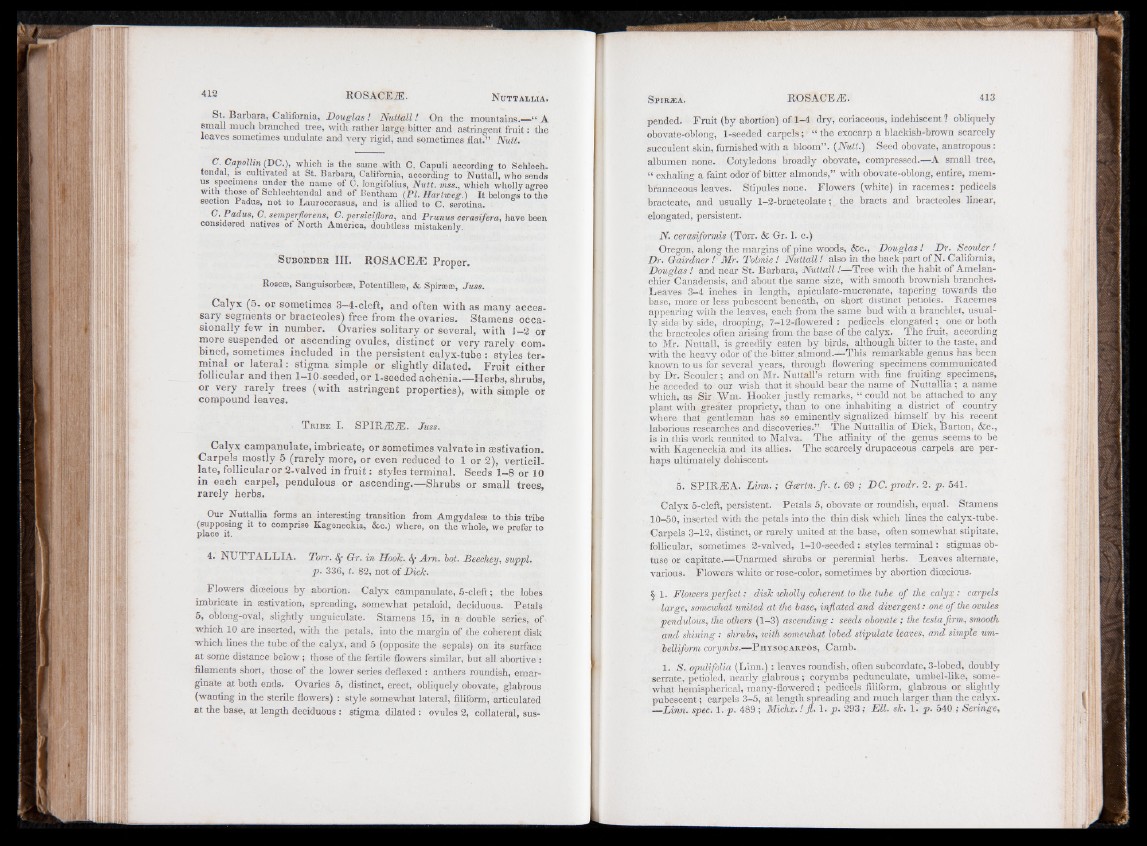
St. Barbara, California, Douglas ! Nuttall! On the mountains.—“ A
small much branched tree, with rather large bitter and astringent fruit: the
leaves sometimes undulate and very rigid, and sometimes flat.” Nutt.
C. C/tpollm (DC.), which is the same with C. Capuli according to Schlech-
tendal, is cultivated at St. Barbara, California, according to Nuttall, who sends
us specimens under the name of C. longifolius, Nutt, mss., which wholly agree
with those of Schlechtendal and of Bentham (PL Hartweg.) It belongs to the
section Padus, not to Laurocerasus, and is alliod to C. serotina.
C.Padus, C. semperjlorens, C. persiciflora, and Prunus cerasifera, have been
considered natives of North America, doubtless mistakenly.
Suborder III. ROSACEAS Proper.
Rose®, Sanguisorbete, Potentillese, & Spine®, Juss.
Calyx (5- or sometimes 3 -4-cleft, and often with as many accessary
segments or bracteoles) free from the ovaries. Stamens occasionally
few in number. Ovaries solitary or several, with 1—2 or
more suspended or ascending ovules, distinct or very rarely combined,
sometimes included in the persistent calyx-tube : styles ter.
minal or la te r a l: stigma simple or slightly dilated. Fruit either
follicular and then 1—10-seeded, or 1-seeded achenia.—Herbs, shrubs,
or very rarely trees (with astringent properties), with simple or
compound leaves.
T ribe I. SPIRiEiE. Juss.
Calyx campanulate, imbricate, or sometimes valvate in aestivation.
Carpels mostly 5 (rarely more, or even reduced to 1 or 2), verticil,
late, follicular or 2-valved in fru it: styles terminal. Seeds 1 -8 or 10
in each carpel, pendulous or ascending.— Shrubs or small trees,
rarely herbs.
Our Nuttallia forms an interesting transition from Amgydale® to this tribe
(supposing it to comprise Kageneckia, &c.) where, on the whole, we prefer to
place it.
4. NUTTALLIA. Torr. 8p Gr. in Hoolc. Sp Am. bat. Beechey, suppl.
p. 336, t. 82, not of Dick.
Flowers dioecious by abortion. Calyx campanulate, 5-cleft; the lobes
imbricate in aestivation, spreading, somewhat petaloid, deciduous. Petals
5, oblong-oval, slightly unguiculate. Stamens 15, in a- double series, of-
which 10 are inserted, with the petals, into the margin of the coherent disk
which lines the tube of the calyx, and 5 (opposite the sepals) on1 its surface
at some distance below ; those of the fertile flowers similar, but all abortive :
filaments short, those of the lower series deflexed : anthers roundish, emar-
ginate at both ends. Ovaries 5, distinct, erect, obliquely obovate, glabrous
(wanting in the sterile flowers) : style somewhat lateral, filiform, articulated
at the base, at length deciduous : stigma dilated : ovules 2, collateral, suspended.
Fruit (by abortion) of 1-4 dry, coriaceous, indehiscent ? obliquely
obovate-oblong, 1-seeded carpels; “ the exocarp a blackish-brown scarcely
succulent skin, furnished with a bloom”. (Nutt.) Seed obovate, anatropous:
albumen none. Cotyledons broadly obovate, compressed.—A small tree,
“ exhaling a faint odor of bitter almonds,” with obovate-oblong, entire, membranaceous
leaves. Stipules none. Flowers (white) in racemes: pedicels
bracteate, and usually 1-2-bracteolate ;. the bracts and bracteoles linear,
elongated, persistent.
N. cerasiformis (Torr. & Gr. 1. c.)
Oregon, along the margins of pine woods, &c., Douglas ! Dr. Scouler !
Dr. Gairdner ! Mr. Tolmie ! Nuttall ! also in the back part of N. California,
Douglas ! and near St. Barbara, Nuttall !—Tree with the habit of Amelan-
chier Canadensis, and about the same size, with smooth brownish branches.
Leaves 3-4 inches in length, apiculate-mucronate, tapering towards the
base, more or less pubescent beneath, on short distinct petioles. Racemes
appearing with the leaves, each from the same bud with a branchlet, usually
side by side, drooping, 7-12-flowered : pedicels elongated; one or both
the bracteoles often arising from the base of the calyx. The fruit, according
to Mr. Nuttall, is greedily eaten by birds, although bitter to the taste, and
with the heavy odor of the bitter almond.—This remarkable genus has been
known to us for several years, through flowering specimens communicated
by Dr. Scouler; and on Mr. NuttaH’s return with fine fruiting specimens,
he acceded to our wish that it should bear the name of Nuttallia; a name
which, as Sir Wm. Hooker justly remarks, “ could not be attached to any
plant with greater propriety, than to one inhabiting a district of country
where that gentleman has so eminently signalized himself by his recent
laborious researches and discoveries.” The Nuttallia of Dick, Barton, &c.,
is in this work reunited to Malva. The affinity of the genus .seems to be
with Kageneckia and its allies. The scarcely drupaceous carpels are perhaps
ultimately dehiscent.
5. SPIRjEA. L in n .; Gcertn.fr. t. 69 ; DC. prodr. 2. p. 541.
Calyx 5-clefi, persistent. Petals 5, obovate or roundish, equal. Stamens
10-50, inserted with the petals into the thin disk which lines the calyx-tube.
Carpels 3-12, distinct, or rarely united at the base, often somewhat stipitate,
follicular, sometimes 2-valved, 1-10-seeded : styles terminal: stigmas obtuse
or capitate.—Unarmed shrubs or perennial herbs. Leaves alternate,
various. Flowers white or rose-color, sometimes by abortion dioecious.
§ 1. Flowers perfect: disk wholly coherent to the tube of the calyx: carpels
large, somewhat united at the base, inflated and divergent: one of the ovules
pendulous, the others (1-3) ascending: seeds obovate ; the testa firm, smooth
and shining : shrubs, with somewhat lobed stipulate leaves, and simple um-
belliform corymbs.—P htsocarpos, Camb.
1. S. opulifolia (Linn.) : leaves roundish, often subcordate, 3-lobed, doubly
serrate, petioled, nearly glabrous; corymbs pedunculate, umbel-like, somewhat
hemispherical, many-flowered ; pedicels filiform, glabrous or slightly
pubescent; carpels 3-5, at length spreading and much larger than the calyx.
—Linn. spec. 1. p. 489 ; Michx. ! fl. 1. p. 293," Ell. sk. 1. p. 540 ; Sennge,